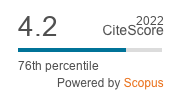Influence of piping processes on the relief evolution. Bardenas Reales (Navarra, Spain)
DOI:
https://doi.org/10.18172/cig.1246Keywords:
Piping, gullies, dispersive clays, physic-chemical propertiesAbstract
Piping processes are controlled by many interacting factors, such as dispersion index and sodium content, SAR and ESP, together with other important factors as cracking density, slope degree and climate. In the study area piping is linked to poor developed soils with high sodium contents which give raise to an intense regolith cracking that favours infiltration and finally piping. As the results show piping in this area can be separated in two different types depending on its genesis, one based on seepage processes, considered as a true type, and another due to tunnelling processes. From a distributional point of view piping is linked to two concrete situations: the massive intermediate levels of the intermediate Holocene filling sediments and the sediments deposited by gullies. In the tertiary materials, in general, it does not manage to develop. On Holocene materials pipes size and scale show a clear relationship among the level thickness, slope and hydraulic gradient, being the first one the principal bounding factor. Pipes developed on the lower laminated levels do not reach important depth due to the high number of discontinuities, generating centimetre-scale conduits that are always on duty to the drainage network. On gullies sediments piping are related to gullies margin evolution and headcut retreat. Pipes size and diameter are a direct function of gully dimensions and are inversely proportional to the proximity to gully scarp. Pipes are on a metric scale with a vertical pattern which development in depth is controlled by upper level thickness, since they are circumscribe to him.Downloads
References
Bryan, R.B., Jones, J.A.A., (1997). The significance of soil piping processes: inventory and prospect. Geomorphology, 20: 209-218.
Desir, G., Marín, C., (2006). Evolución y procesos de erosión en gullies. Bardenas Reales (Navarra). España. En: Geomorfología y Territorio (Pérez-Alberti, A., López-Bedoya, J., Eds.), Sociedad Española de Geomorfología. Universidad de Santiago de Compostela.
Marín, C., Desir, G., (2004). Influencia de las propiedades físico-químicas del regolito en los procesos de erosión. Bardenas Reales (Navarra). En: Riesgos Naturales y Antrópicos en Geomorfología (Benito, G., Díez Herrero, A., Eds.), Sociedad Española de Geomorfología. Madrid.
Desir, G., Marín, C., Guerrero, J., (2005). Badlands and Talus Flatirons in the Bardenas Reales Region. Field Trip Guide B3. VI International Conference on Geomorphology. Zaragoza.
Faulkner, H., Spivey, D., Alexander, R., (2000). The role of some site geochemical processes in the development and stabilisation of three badland sites in Almería, southern Spain. Geomorphology: 35, 87-99.
Gracia, F.J. (1986). Geomorfología de las Bardenas Orientales. Tesis de Licenciatura. Universidad de Zaragoza
Gutiérrez, M., Sancho, C., Desir, G., Sirvent, J., Benito, G., Calvo, A., (1995). Erosión Hídrica en Terrenos Arcillosos y Yesíferos de la Depresión del Ebro. Ministerio de Agricultura, Pesca y Alimentación. Universidad de Zaragoza, 389 pp., Zaragoza.
Jones, J.A.A., (1981). The nature of soil piping: a review of research. British Geomorphological Research Group Monograph Series 3. Geobooks, Norwich. 1015
Martínez-Casasnovas, J.A., Ramos, M.C., Poesen, J., (2004). Assessement of sidewall erosion in large gullies using multi-temporal DEMs and logistic regression analysis. Geomorphology, 58, 305-321.
Downloads
Published
How to Cite
Issue
Section
License
The authors retain copyright of articles and authorize Cuadernos de Investigación Geográfica / Geographical Research Letters the first publication. They are free to share and redistribute the article without obtaining permission from the publisher as long as they give appropriate credit to the editor and the journal.
Self-archiving is allowed too. In fact, it is recommendable to deposit a PDF version of the paper in academic and/or institutional repositories.
It is recommended to include the DOI number.
This journal is licensed under a Creative Commons Attribution 4.0 International License











